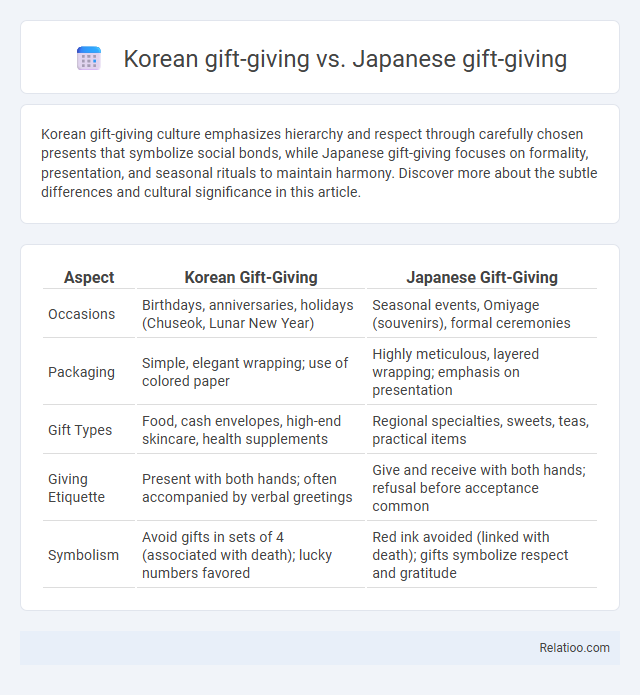Korean gift-giving culture emphasizes hierarchy and respect through carefully chosen presents that symbolize social bonds, while Japanese gift-giving focuses on formality, presentation, and seasonal rituals to maintain harmony. Discover more about the subtle differences and cultural significance in this article.
Table of Comparison
| Aspect | Korean Gift-Giving | Japanese Gift-Giving |
|---|---|---|
| Occasions | Birthdays, anniversaries, holidays (Chuseok, Lunar New Year) | Seasonal events, Omiyage (souvenirs), formal ceremonies |
| Packaging | Simple, elegant wrapping; use of colored paper | Highly meticulous, layered wrapping; emphasis on presentation |
| Gift Types | Food, cash envelopes, high-end skincare, health supplements | Regional specialties, sweets, teas, practical items |
| Giving Etiquette | Present with both hands; often accompanied by verbal greetings | Give and receive with both hands; refusal before acceptance common |
| Symbolism | Avoid gifts in sets of 4 (associated with death); lucky numbers favored | Red ink avoided (linked with death); gifts symbolize respect and gratitude |
Introduction to Korean and Japanese Gift-Giving Traditions
Korean gift-giving traditions emphasize respect, hierarchy, and the symbolism of wrapped gifts, often using bojagi cloth to express sincerity and care. Japanese gift-giving customs revolve around omotenashi hospitality and seasonal exchanges, highlighting presentation, modesty, and the significance of both giving and receiving rituals. Comparing Korean and Japanese practices reveals shared cultural values alongside distinct approaches influenced by historical, social, and philosophical backgrounds.
Historical Roots of Gift-Giving in Korea and Japan
Gift-giving in Korea is deeply rooted in Confucian traditions emphasizing social harmony and respect, with historical practices such as Jesa ceremonies and Chuseok gifts reflecting family and community bonds. In Japan, gift-giving traces back to the Heian period, influenced by Buddhist rituals and the concept of "giri" (duty), embedding gifts in social obligation and politeness rituals like Ochugen and Oseibo. Both cultures share a historical foundation of using gifts to reinforce relationships and social hierarchy, yet Korea focuses more on ancestral respect while Japan highlights reciprocal social duty.
Cultural Significance of Gift-Giving
Gift-giving in Korea emphasizes respect and social hierarchy, with a strong focus on wrapping and presentation to convey sincerity and care, often involving reciprocal exchanges to maintain harmony. Japanese gift-giving culture values formality, seasonal customs, and the concept of "giri" (obligation), where gifts symbolize respect, gratitude, and the maintenance of social bonds through precise rituals and etiquette. Compared to general global practices, both Korean and Japanese gift-giving are deeply embedded in cultural traditions that reinforce social relationships through carefully prescribed gestures and meanings.
Types of Popular Gifts in Korea and Japan
Korean gift-giving commonly features items such as health supplements, high-quality fruits, and luxury skincare products, reflecting a cultural emphasis on well-being and respect. In contrast, Japanese gift-giving often includes elegantly packaged sweets, seasonal fruits, and artisanal crafts, underscoring meticulous presentation and tradition. Both cultures prioritize thoughtful, high-quality gifts, but Koreans favor practical items while Japanese gifts highlight aesthetic appeal and cultural significance.
Gift Presentation and Wrapping Customs
Korean gift-giving emphasizes elaborate presentations with colorful fabric wraps called bojagi, symbolizing good fortune and care. Japanese gift presentation is renowned for its meticulous wrapping using washi paper and intricate mizuhiki cords, reflecting respect and mindfulness toward the recipient. In general gift-giving cultures, wrapping customs vary widely but often involve attention to detail as a sign of appreciation and thoughtfulness.
Etiquette and Social Norms in Gift Exchange
Korean gift-giving emphasizes humility and respect, often requiring the receiver to modestly decline before accepting, with gifts typically wrapped in traditional bojagi cloth to convey sincerity. Japanese gift-giving revolves around precision and formality, where the act of giving and receiving follows strict protocols such as presenting gifts with both hands and avoiding certain numbers and colors that may imply bad luck. Both cultures stress the importance of reciprocity and timing in gift exchange, reflecting deep-rooted social norms that reinforce relationships and social harmony.
Special Occasions for Gift-Giving
Korean gift-giving during special occasions emphasizes respect and reciprocity, often involving meticulous wrapping and the exchange of monetary gifts (known as "sae bae don") during Lunar New Year and Chuseok. Japanese gift-giving customs prioritize the aesthetic presentation and seasonal appropriateness of gifts, with rituals such as "Ochugen" and "Oseibo" reflecting gratitude and maintaining social harmony. Both cultures value the timing, manner, and symbolism of gifts, contrasting with general gift-giving practices that may prioritize personal preference or spontaneity over cultural protocol.
Differences in Reciprocity and Gift Value
Korean gift-giving emphasizes hierarchical relationships with strict expectations for reciprocity based on social status, often requiring gifts of higher value to maintain balance and honor. Japanese gift-giving prioritizes harmony and subtlety, where gifts are carefully selected to reflect thoughtfulness, and reciprocity is managed to avoid direct equivalence, often favoring modest value to prevent obligation. In general gift-giving practices, reciprocity varies widely, but Korean culture distinctly enforces reciprocal value matching, while Japanese customs focus on understated gestures and social harmony over gift worth.
Taboos and Gifts to Avoid
Korean gift-giving customs emphasize avoiding gifts that symbolize death or misfortune, such as clocks or handkerchiefs, as they are considered taboo and bring bad luck. Japanese gift-giving strictly prohibits items like scissors or knives, which suggest severing relationships, and gifts wrapped poorly or in sets of four, since the number four is associated with death. In both cultures, avoiding gifts that evoke negative superstitions is crucial to maintain respect and harmony in social and business interactions.
Modern Trends in Korean and Japanese Gift-Giving
Modern Korean gift-giving emphasizes personalized and practical presents, often reflecting trends like K-beauty products and tech gadgets, with a strong focus on wrapping aesthetics and social etiquette. In Japan, contemporary gift-giving continues to value traditional aspects such as seasonal gifts and omotenashi (hospitality spirit), while incorporating modern minimalistic packaging and eco-friendly materials. Both cultures prioritize respect and thoughtfulness, adapting old customs to suit fast-paced urban lifestyles and global influences.

Infographic: Korean gift-giving vs Japanese gift-giving
 relatioo.com
relatioo.com